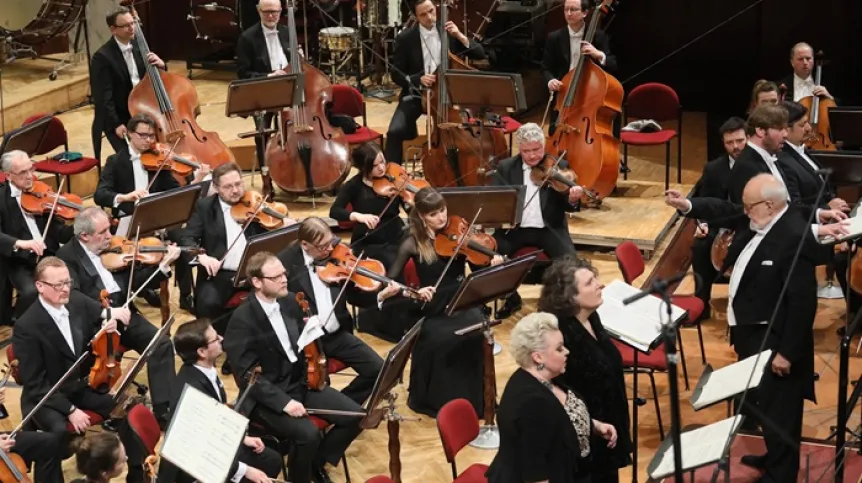
Laypeople have chills as often as experts do when listening to Krzysztof Penderecki's Seven Gates of Jerusalem. Although experts analysed fragments of the piece more, its emotional reception did not differ depending on the level of preparation of the audience, the Jagiellonian University experiment shows.
Although the main reason we listen to music are the emotions it gives us, scientific research proves that its effects are much more diverse. Sounds - as reported by the Jagiellonian University Centre for Brain Research - can activate brain regions and create new connections between them, thanks to which we can be, for example, more efficient intellectually.
Previous studies, conducted, for example at McGill University, have shown that in people who have so-called chills while listening to music, deeper, subcortical brain structures are activated. Psychologist Matthew Sachs noticed that people experiencing chills had a greater number of neural connections between the auditory cortex and the anterior insular cortex (responsible for integrating experiences from different senses, and for emotional experiences) and the medial prefrontal cortex (responsible for emotional control, among other things).
To what extent can these results be translated into the reception of contemporary music, often considered hermetic and evoking strong, difficult-to-identify emotions? That was what scientists from the Jagiellonian University Brain Research Centre and the Krzysztof Penderecki European Centre for Music in Lusławice wanted to find out.
They conducted an experiment in which participants listened to 11 selected fragments of Krzysztof Penderecki's composition Seven Gates of Jerusalem. This piece is known, among other things, for its particular dramaturgy and high degree of sound texture complexity. The fragments were selected by Professor Maciej Tworek - a conductor, expert and interpreter of Krzysztof Penderecki's work.
Ten people took part in the study using magnetic resonance imaging: five laypeople and five experts, connoisseurs of contemporary music, including Professor Maciej Tworek himself. Nearly 40 other people were asked to listen to the composition and determine the emotional meaning of a given fragment as, for example, lyrical, sinister, solemn, dance-like, neutral.
'The starting point for us was to examine the degree of understanding of the musical language of this composition. We also wanted to examine something that in the narrative regarding this project we call moving moments, colloquially we call them 'chills', 'shivers', i.e. physiological sensations associated with a strong emotional reaction caused by listening to music', says Professor Michał Wierzchoń, director of the Jagiellonian University Centre for Brain Research.
It turned out that the auditory cortex was activated less in experts than in laypeople. According to Professor Michał Wierzchoń, this may be due to their better knowledge of the piece. 'The experts' brains reacted less to the stimuli. Professor Maciej Tworek emphasised in the discussion on the results of the experiment that when he listened to these fragments, he anticipated what would happen next in the piece. This previous experience may be the reason for the difference between laypeople and experts', Wierzchoń points out.
During the MRI scan, the scientists also observed stronger activation of the prefrontal regions of the cerebral cortex in experts. It is responsible for the functioning of working memory, planning and predicting the consequences of decisions. 'The experts analysed the fragments of the symphony to a greater extent, they experienced them in a more analytical manner', the cognitive psychologist says.
According to the researcher, even with such a small group of subjects, it was possible to observe physiological reactions caused by listening to music, the so-called chills. The fragments that the subjects described as important and moving, at a physiological level, activated parts of the brain that make up the salience network, including the cingulate cortex, the insular cortex, and the frontal gyrus.
'Special moments appeared very systematically in experts primarily in solemn moments, i.e. where we would expect them to. The reactions in laypeople were varied, which is interesting - because it shows that their perception of the music was more individual', the researcher describes. 'On average, in each person we observed about twenty emotional moments while listening to these 11 fragments. Analysis of the activation of the limbic system, i.e. the regions responsible for processing emotions, shows that both groups experienced emotions associated with listening to this music to the same extent. So it is not true that experts already know this piece so well that they do not experience any emotions associated with it, nor is it true that this music is incomprehensible to laypeople, so they do not show this type of reaction'.
The analysis, in which a given fragment had to be assigned to a specific category of emotional meaning, did not differ significantly between experts and laypeople. 'We can see that the programmatic nature of this music (rendering an extramusical narrative through music - ed. PAP) was so distinct that laypeople also noticed it. Our subjects therefore perceived this piece emotionally, regardless of their level of preparation', the researcher concludes.
Although the group on which the experiment was conducted is too small to publish the result in a scientific journal, the researchers want to conduct similar analyses in the future. They intend to check, among other things, whether similar results can be observed in the case of other works of contemporary music. (PAP)
Ewelina Krajczyńska-Wujec
ekr/ zan/ amac/













